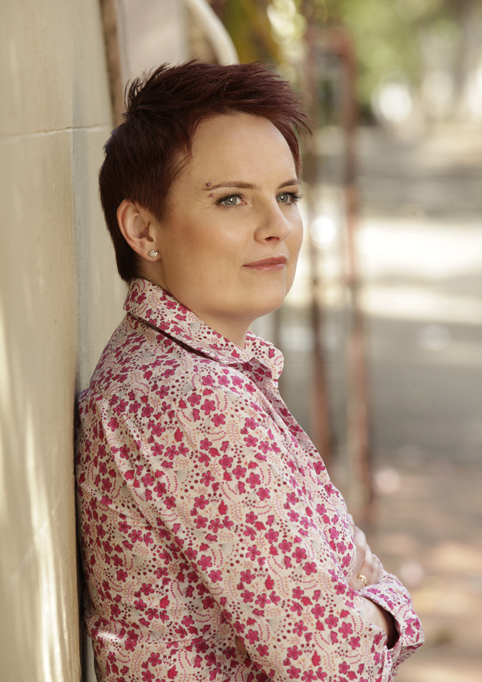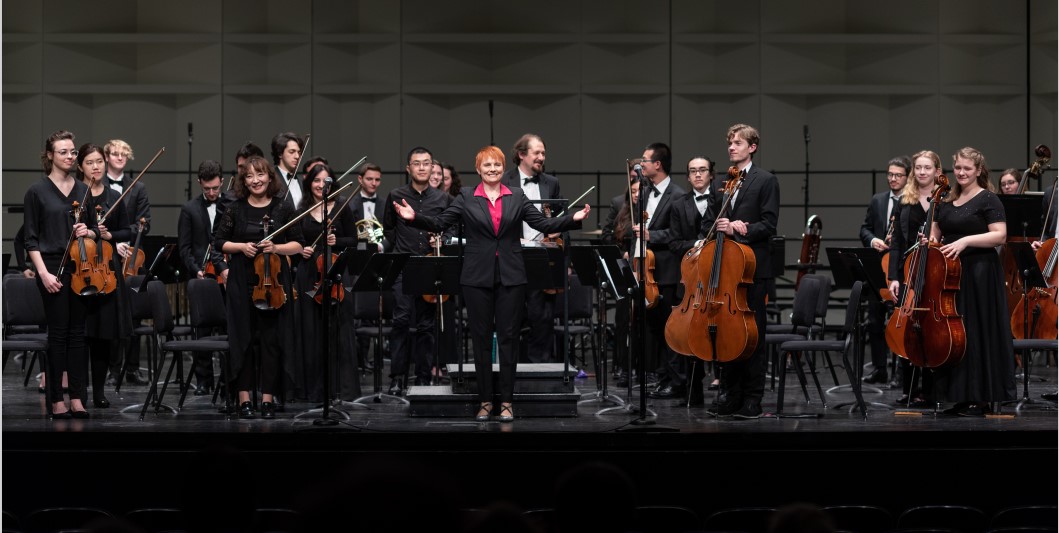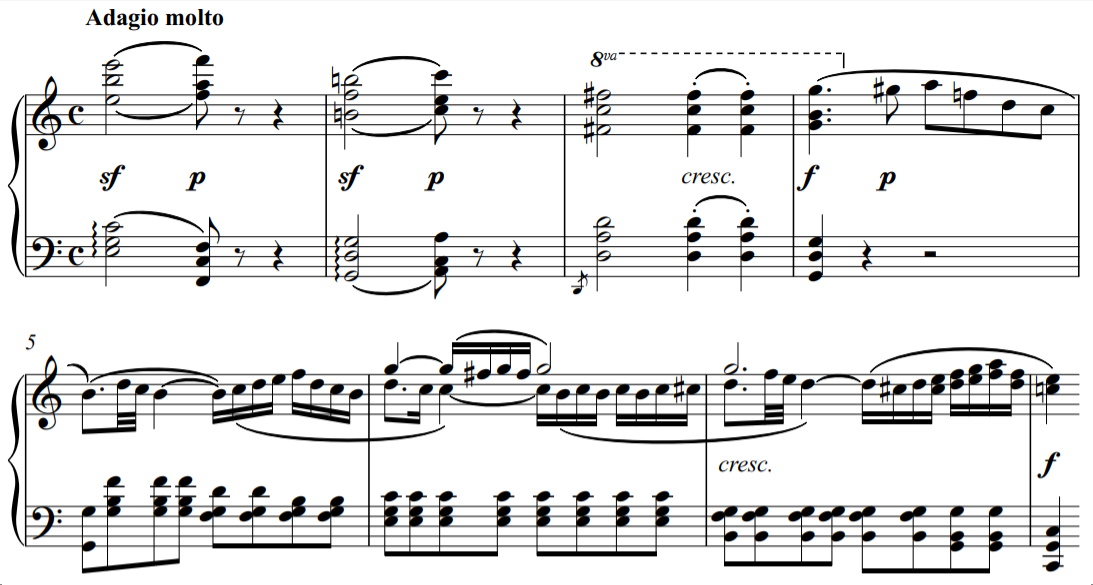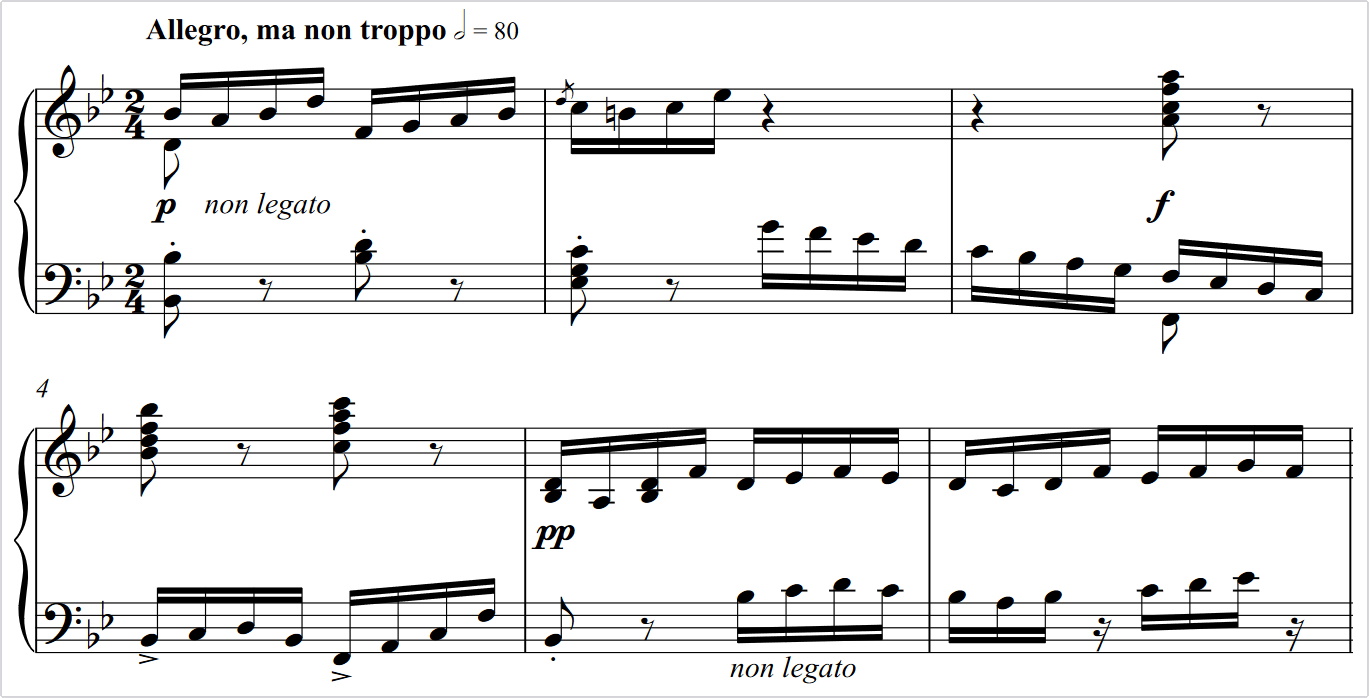A Reimagined Beethoven Cycle
Table of Contents
Martin Nedbal
Dr Martin Nedbal is Associate Professor of Musicology at the University of Kansas. His research focuses on Mozart, Beethoven, and Czech music. His books, Morality and Viennese Opera in the Age of Mozart and Beethoven and The Published Theoretical Works of Leoš Janáček, appeared in 2017 and 2020.
Carolyn Watson
Dr Carolyn Watson is Director of Orchestral Studies at the University of Kansas. She has conducted orchestras throughout the United States including Austin Symphony, Dallas Opera, Detroit Symphony Civic Orchestra, Kansas City Ballet, Lyric Opera of Kansas City and World Youth Symphony Orchestra. She holds a PhD in Performance (Conducting) from the University of Sydney. www.carolyn-watson.com
by Martin Nedbal and Carolyn Watson
Music & Practice, Volume 8
Reports and Commentaries
This article details an innovative and reconfigured approach to a traditional cycle of Beethoven’s symphonies, leading to a performance in September 2020 by the University of Kansas Symphony Orchestra. This ensemble typically presents three major concert projects each semester meaning that a complete Beethoven Cycle is beyond the scope of possibility, given the need to offer a diverse and varied course of orchestral study in the timeframe involved. Thus, rather than selecting one particular Beethoven symphony to study and perform, the KU Symphony Orchestra conveyed a holistic palette of Beethoven’s symphonic oeuvre to both orchestral students and our audience by presenting individual movements from the first eight symphonies, combined into two ‘unheard’ symphonies. This approach created a semiquincentennial retrospective and offered an opportunity to charter the development of Beethoven’s compositional style over the course of his most prolific creative period. The following pages discuss the rationale behind the selection of movements for the reimagined cycle and provide historical and aesthetic justifications for this programming concept.
The nine symphonies of Beethoven are recognized as a benchmark, one which arguably defines the genre of the symphony as a whole. From the familiar opening motif of the Fifth Symphony to the widely recognizable Ode to Joy melody of the Ninth, Beethoven’s symphonies enjoy popular appeal with concert audiences. Due in part to this widespread appeal, the orchestral works of Beethoven are among the most performed of any composer. A survey of recorded works also confirms the popularity of Beethoven’s symphonies, which have been released as a complete cycle on no less than 175 occasions.[1] For artistic administrators at the helm of professional ensembles, a Beethoven symphony cycle is a guaranteed ‘people-pleaser’, an event which is reliably able to ensure success at the box office. As a result, in this year, the 250th anniversary of the composer’s birth, orchestras are particularly focused on presenting the works of Beethoven: the overtures, concertos and choral works, but above all, the symphonies. For instance, this season sees complete Beethoven symphony cycles planned by a number of the world’s most revered ensembles including the Chamber Orchestra of Europe, Chicago Symphony, The Hallé, London Philharmonic, Philadelphia Orchestra, Vienna Philharmonic, and the period instrument ensemble, Orchestre Révolutionnaire et Romantique. A consortium of five leading orchestras from throughout the United Kingdom also teamed up to present all nine symphonies in one weekend.[2]
2020 Beethoven Cycle at the University of Kansas
The University of Kansas’ 2020 Beethoven Cycle featured two ‘unheard’ symphonies of the composer, each comprising four movements in the standard classical format, with one movement selected from each of the first eight symphonies. The design was as follows:
Symphony No. 1 in C Major, op. 21, First Movement (Adagio molto – Allegro con brio)
Symphony No. 2 in D Major, op. 36, Second Movement (Larghetto)
Symphony No. 3 in Eb Major, Eroica, op. 55, Third Movement (Scherzo: Allegro vivace)
Symphony No. 4 in Bb Major, op. 60, Fourth Movement (Allegro ma non troppo)
INTERMISSION
Symphony No. 8 in F Major, op. 93, First Movement (Allegro vivace e con brio)
Symphony No. 7 in A Major, op. 92, Second Movement (Allegretto)
Symphony No. 6 in F Major, Pastoral, op. 68, Third Movement (Allegro)
Symphony No. 5 in C Minor, op. 67, Fourth Movement (Allegro)
The motivating factors behind this approach were manifold, and were based on both scholarship and pragmatism. For each ‘unheard’ symphony a typical Beethovenian four movement symphonic structure was maintained, offering a familiar formal construct in which to present the selected movements. The movements were selected and ordered in a cohesive manner, with a degree of consideration attributed to the overall length and structure of the symphony, the sequence of the selected movements, and, to a degree, a sense of harmonic and tonal cohesion.[3]
Crafting the Unheard Symphonies
The selection of movements for the first ‘unheard’ symphony was in many ways much easier than the selection of movements for the second, in that there are a number of obvious commonalities between Symphonies 1, 2 and 4. These works all begin with a slow Haydn-esque introduction and are very much ‘classical’ works in terms of instrumentation, structure and length. The opening movement of the First begins with a slow introduction before the transition to the main Allegro. In contrast to other works of this ilk,[4] Beethoven’s First Symphony appears to begin in the ‘wrong’ key before gradually making its way to the tonic, an aspect which would have been shocking to audiences of the day (See Figure 1). As the first movement of the First Symphony, this movement marks the beginning of Beethoven’s career as a symphonist, making it an ideal candidate for inclusion. The structure and style of this movement is also replicated in Symphonies 2 and 4, and thus establishes something of a precedent for Beethoven’s treatment of first movements in his early symphonic works.
Somewhat interestingly, the second movement of the Second Symphony is the only Larghetto in all nine symphonies, but it is nonetheless representative of the composer’s treatment of lyrical movements in these early works. As with the second movements of the First and Fourth, it is in sonata form.[5] Another aspect that unifies these works is the use of a triple metre for the second movements of Symphonies 1, 2 and 4. The Larghetto of the Second and the Andante cantabile con moto of the First are also similar in that the tempo designations Beethoven provided (quaver equals 92 in the Larghetto, and 120 in the Andante cantabile) are indicative of a moderate tempo rather than a slow one, a device Beethoven continued to favour for the second movement of his symphonic works.[6]
The final movement of the Fourth is a virtuosic tour-de-force and feels in many ways almost as a perpetuum mobile, one which brings the first ‘unheard’ symphony to a jubilant close (see Figure 2). In the same vein as the final movements of Symphonies 1 and 2, this fourth movement provides a distinctly Beethovenian blend of extreme energy and dramatic dynamic contrasts, alongside what appears, at times, almost a quirky humorous character, most notably in the final phrase (bars 335–55), where the incessant motion appears to come to a gradual halt via the augmentation of the rhythmic values of the opening theme, supplemented by a series of surprise fermatas on the final notes of the phrase before the movement concludes in one last brash flourish of energy.
Of Beethoven’s first four symphonies, the Eroica is singular in many respects. A work of significantly greater length, scope and complexity than the First, Second, and Fourth Symphonies, the Eroica ranks among the most performed symphonies of the composer along with the Fifth, Seventh, and Ninth. The Eroica is also notably distinct in that it is the only symphony of the first four which does not begin with a slow introduction. Its first movement, at some twenty minutes’ duration, is approximately double that of the corresponding opening movement in the other three symphonies, leading to its exclusion. Similarly, the second movement, Marcia funebre, is also something of an outlier when considered in the context of the first four symphonies as is its concluding movement, a finale in an extended theme and variations form, a structure not replicated elsewhere in the composer’s early symphonic output. The most archetypal Beethovenian movement of the Eroica is the scherzo (see Figure 3). The third movement scherzo represents one of the most defining characteristics of Beethoven’s symphonic writing and is also arguably one of the composer’s most significant innovations with respect to form.[7] Beethoven’s scherzos are usually energetic and humorous, with a pulse of one beat per bar, and frequent sudden and extreme dynamic contrasts. These features dominate the Eroica scherzo, hence its place in the first ‘unheard’ symphony. With respect to instrumentation, the Eroica is the only symphony of the first four to offer some variance from the classical norm, albeit in significantly more limited scope than is observable from the Fifth Symphony onwards.[8] The Eroica specifies the addition of a third horn which is featured most prominently in its scherzo movement, a further motivating factor behind the inclusion of this movement.
Rather than an entirely random assemblage of movements in various keys, there is something of a connection between these selected movements whose keys are C–A–E-flat–B-flat respectively. While not adhering to the accepted harmonic architecture of the symphony per se, there remains nonetheless a degree of logic which links the transitions from one movement to the next. A second movement in the submediant key of the first is by no means unusual for a symphonic work in the nineteenth century, and indeed Beethoven adopts this approach most notably in the Fifth Symphony. Steven Craig Cannon confirms that ‘for slow movements, the subdominant is the most common key in major-key symphonies, followed by the submediant’.[9] Moving from the second movement in A major to the scherzo in E flat major is the most striking tonal shift in the first ‘unheard’ symphony, although this, too, is not too far fetched, particularly when considered in the context of Beethoven’s predilection for distant tonal centres and key relationships. The scherzo of the Eroica, while in E flat major, gives the initial appearance of being in B flat major. The movement opens by suggesting a degree of ambiguity with the binary alternation of the pitches B flat and C in the first violins, joined in bar 8 by the oboe with the opening melody, a phrase clearly and most definitively in the key of B flat major.
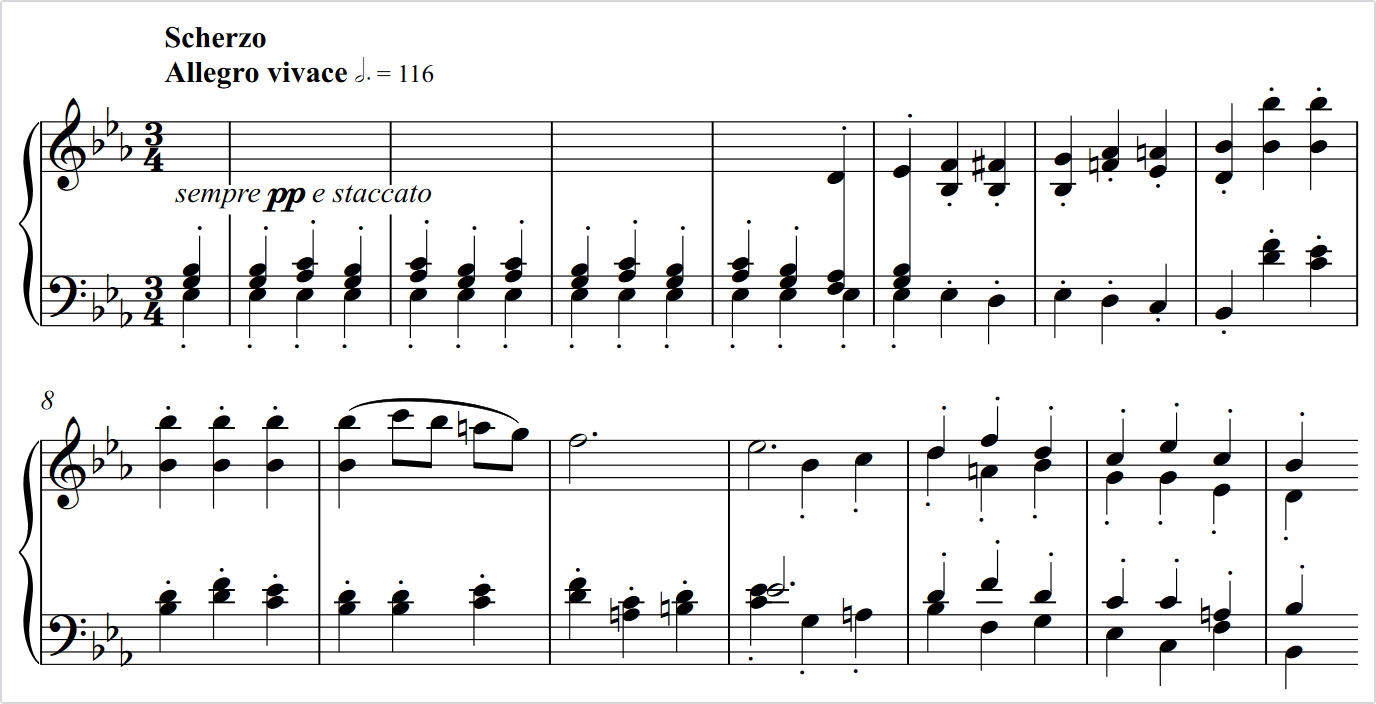
Figure 3 Symphony No. 3 in Eb Major, Eroica, op. 55, Third Movement (Scherzo: Allegro vivace), (bars 1–13).
If we accept the scherzo as beginning in B flat major, the tonal shift is then up a half step, from A to B flat major as we transition from the second movement to the third. A semitone shift from one seemingly unrelated key to another is evidenced by the composer’s own use of a similar device in the motion from B to B flat major at the conclusion of the second movement of the Emperor Concerto, in this instance, serving as a vehicle to steer us back to the tonic (E flat major) for the final movement of the work (bars 79–80).
Indeed, Beethoven was in many ways a pioneer in the realm of tonal ambiguity and creative harmonic progressions. In addition to the opening of the First Symphony in the ‘wrong’ key, the introduction of the Fourth appears to deliberately avoid any obvious tonal or triadic commitment, preferring to meander chromatically for some thirty-five bars before the fortissimo announcement of the dominant in the transition to the Allegro vivace. In the words of Leonard Bernstein, the Fourth Symphony begins with a ‘mysterious introduction which hovers around minor modes, tip-toeing its tenuous way through ambiguous unrelated keys and (is) so reluctant to settle down into its B flat major’.[10] Similarly, the harmonic ambiguity inherent in the opening of the Fifth and Ninth Symphonies, as well as the late string quartets is very well researched and documented.[11]
Concluding in E flat major, the scherzo then paves way for the final movement, the fourth of the Fourth, in B flat major. Again, while not conforming to the standard tonal outline of the symphony overall, this connection between E flat and B flat major, two closely related keys, creates a degree of harmonic cohesiveness between the final two movements.
Similar considerations were employed in the selection of movements for the second ‘unheard’ symphony. Symphonies 5–8 offer more variety than 1–4 in terms of structure, form and instrumentation, so a conscious effort was made to highlight Beethoven’s innovations in these respects. With the exception of the additional horn in the Eroica and the use of a single flute, rather than the more usual two in the Fourth, orchestration remains consistent within the first four Beethoven symphonies. In contrast, the Fifth sees the addition of a piccolo, contrabassoon and three trombones while the Sixth also includes piccolo and two trombones. The Seventh and Eighth see a return to standard classical instrumentation of double winds, horns and trumpets, before the groundbreaking ensemble that comprises the Ninth, which includes piccolo, contrabassoon, four horns, three trombones, percussion, four vocal soloists and chorus. Nonetheless, the more traditional scoring of the Seventh and Eighth was not necessarily reflected by the performing forces involved at the actual premiere. Clive Brown reports that for the premieres of these two symphonies, thirty-six violins were used, along with doubled winds and timpani, inspired by ‘Beethoven’s known practice for large-scale performances’.[12] As such, a decision was made to augment the size of the string section for the second ‘unheard’ symphony in order to more accurately reflect the variety in orchestral size during Beethoven’s career.
While the opening motif of the Fifth Symphony is arguably among the most recognizable four notes in the orchestral canon, our second ‘unheard’ symphony features the final movement of that symphony to showcase the inclusion of the piccolo, contrabassoon and trombones as these instruments are not included in the first three movements. Another notable feature of the Fifth’s finale is the return to the theme of the previous movement preceding the recapitulation. While unifying melodic and rhythmic elements between movements are recognizable aspects of Beethoven’s symphonic writing,[13] no other work under consideration is formatted to include a direct quotation from another movement, another reason this movement was selected to conclude the second ‘unheard’ symphony.[14]
The Sixth is notable for its programmatic associations and five-movement structure, an innovation which was subsequently employed by composers including Berlioz, Schumann, Mahler and Shostakovich.[15] The inclusion of the scherzo from the symphony stems from the character of the movement itself – when contrasted with the other third movements under consideration, it exemplifies a quintessentially Beethovenian scherzo. Of the Seventh, it is the second movement which has assumed a leading degree of prominence relative to the other movements, and was felt a better fit than the lengthy second movement of the Sixth, or the quirky second movement of the Eighth. Beginning the second ‘unheard’ symphony with the first movement of the Eighth then results in an overall key structure of F–A minor–F–C to present a relatively homogenous symphony from a tonal perspective, albeit a non-conventional one.
The idea of unity
By combining individual movements from different symphonies, the reimagined Beethoven cycle sheds new light on the notion of unity, which is often associated with Beethoven’s music. This combination puts the concept of a symphony as a unified work of art to test. Beethoven’s symphonies in particular provide some of the earliest and most famous examples of musical unity across individual movements. The Fifth Symphony is the most well-known case, and ever since E. T. A. Hoffmann’s 1810 review of the work in the Allgemeine musikalische Zeitung, commentators point out that Beethoven derives most of the musical material in all movements from a single opening motive. Besides motivic relations, the C minor–major trajectory also creates a unifying narrative for the four movements, which suggests a tragedy-into-triumph plot. Other types of unity can be found in the symphonies that followed the Fifth. The individual movements of the Sixth Symphony (Pastoral) are famously bound by the idea of feelings associated with recollections of country life.[16] Though it lacks a prominent narrative arch or thematic returns, the Seventh Symphony is unified through the reliance on repetitive, march-like rhythms. The four movements of the Eighth Symphony, by contrast, rely on buffo styles and ‘neo-classical’ references to music of the late eighteenth century.
The concept of overall unity, however, is not as clear in Beethoven’s first four symphonies. The most famous of these four, the Third Symphony (Eroica), is unified by the general theme of heroism however the individual movements are in fact quite distinct, even disparate. This is most prominent in the switch from the triumphant ending of the first movement to the funeral march in the second. More explicit links across movements appear only in the Fourth Symphony, but they are connected to individual sections, not an overall outlook. For example, both the first and fourth movements of the Fourth Symphony feature buffo-like solos for a virtuosic bassoon (bars 65–80 in the first movement, bars 184–87 in the fourth), but these momentary events do not obviously connect to a larger idea.
The idea of organic unity and coherence within musical works has been subject to deconstructive criticism in the past decades. As Fred Everett Maus has pointed out, for example, ‘analysts and critics have overemphasized unity, at the expense of other values’.[17] Already in 1980, Joseph Kerman claimed that the analytical focus on unity was ideological and Germano-centric and that ‘analysis exists for the purpose of demonstrating organicism, and organicism exists for the purpose of validating a certain body of works of art’.[18] Kerman stressed the importance of finding ‘ways of dealing with other kinds of aesthetic value in music besides organicism’.[19] Instead of the search for organic unity within the composition itself, Maus calls an appreciation of ‘the unity of a listening experience’.[20]
The reimagined Beethoven cycle affords the audience a listening experience that is based not on the concept of organic and coherent four-movement symphony but on the idea of a coherence among individual symphonic movements. A fundamental element of traditional analytical approaches to Beethoven’s symphonies the reimagined cycle allows us to overcome is reliance on tonality as a unifying factor. The absence of accepted tonal structures across movements creates the potential to explore unities and connection based on elements other than traditional subjects of analytical enquiry. Instead of tonality, the reimagined cycle may encourage analytically minded listeners to focus on issues connected to rhythm, melodic development, orchestration, and style. Listeners and performers will surely find many unifying aspects in the newly created symphonic combinations. The combinations, furthermore, do provide ample opportunity for experiencing across-the-movement unities. In the first reimagined symphony (consisting of movements from Symphonies 1–4), attentive listeners will be able to notice analogous, and typically Beethovenian, approaches to the beginnings of movements 1, 3, and 4, where the composer plays with listeners’ expectations. The slow introduction of the first movement opens with a perfect authentic cadence in the wrong key (F major as opposed to C major), the third movement opens with a crotchet upbeat that is accentuated in the same way as the following crotchets, which makes it difficult to recognize immediately where the actual downbeat falls; the oscillation between two pitches in the upper strings, furthermore, creates the impression of a duple metre which clashes with the actual triple metre. The fourth movement starts in medias res with a fast-paced semiquaver figuration and a seemingly premature heavy cadence on the downbeat of bar 5, which is moreover undercut by a sudden switch from forte to pianissimo. The relentlessly driven semiquaver figurations in the fourth movement, furthermore, fittingly complement the opening of the first movement’s fast section, where the strings try to jump start a similarly energetic driving quaver pulse but are twice stalled by the winds.
Just as in the original works, the first reimagined symphony also incorporates stylistic relations across movements. One example is the previously mentioned connection between the fast-paced, brilliant opening idea of movement four and the analogous idea at the beginning of the Allegro con brio in movement one. Elements of the machine-like brilliance can also be detected in the demisemiquaver figurations within the secondary theme of the second movement (they first emerge in bar 52). Another connection is that between the pastoral and serenely lyrical second movement and the trio section of the third movement, both of which include prominent horn calls, which are sometimes imitated by other instruments.
Although the second reimagined symphony consists of movements from works that are more obviously integrated in themselves and hearing them out of context might therefore be more unusual, there are in fact ample opportunities to find large-scale continuities in the re-ordered work. Both the fourth movement of the Fifth Symphony and the second movement of the Seventh are based on duple-metre marches, and the first movement of the Eighth Symphony (the first movement of the ‘unheard’ second symphony) prefigures these marches thanks to the militaristic hemiola fanfares that first appear in the closing section of the exposition (bars 70–72 and 80–82). The famous relentless ostinato in the Seventh Symphony’s second movement has a counterpart of sorts in the Eighth Symphony’s first movement, where a repetitive rhythmic figure concludes the exposition and recapitulation and initiates both the development and the extensive coda. A more prominent connection becomes apparent between the second movement of the Seventh and the third movement of the Sixth Symphony, both of which are based on multiple ostinatos.
The reimagined cycle therefore allows us to pursue an analytical exercise with which commentators on Beethoven’s symphonies are quite familiar: the practice of tracing later works in earlier ones and also of connecting Beethoven’s symphonic procedures to specific works of earlier composers, particularly Haydn and Mozart. Thus the third movement of the First Symphony is viewed as the starting point for Beethoven’s later scherzo movements, although in the First Symphony Beethoven still uses the genre designation ‘Menuetto’. Similarly, the sudden outburst of D minor in bar 23 of the slow introduction of the Second Symphony can be easily connected to the main theme of the Ninth Symphony’s first movement. The process of measuring Beethoven’s works against the achievements of earlier composers is common especially in the scholarship and criticism focused on Beethoven’s first two symphonies – comparisons to the late symphonies of Haydn and Mozart abound.
Canon and Authenticity
The reimagined cycle also touches on issues of canon formation and authenticity of performance practices. In most present-day symphony concerts, Beethoven’s symphonies are presented as the highpoint, often as the only work of the second half. This practice imbues these works and their presentation with an aura of immense aesthetic significance and autonomy: audience members are led to believe that these works need to be quietly contemplated and worshipped in their organic entirety. But many previous studies have shown that concert programming was by no means standardized nor stable for a large part of the nineteenth century, and symphonies were not necessarily considered structurally untouchable and autonomous. William Weber has shown that symphonic programmes varied greatly at any one time depending on performing resources, institutional limitations and social conditions.[21] Weber also points out that for much of the nineteenth century symphonies tended to be played at the beginnings or ends of concerts, thus functioning as ‘pieces designed to bring the audience to attention as people settle in the hall, or as finales to long programmes which listeners often left early’.[22] The process of rearranging excerpts of Beethoven’s symphonies into two new works can therefore be seen as an attempt to explore the heterogeneity of performance and programming practices that accompanied the genre for most of its early history.
The reimagined cycle, furthermore, illuminates the complexities and contradictions of the Western musical canon. It is undeniable that Beethoven’s music represents one of the central aspects of the musical canon, a group of works that generations of musicians, critics, scholars, and music lovers have imbued with immense artistic and ideological value. And yet, even among the nine symphonies of Beethoven, there is a clear distinction between the centrality and supposed profundity of the odd-numbered works (starting with the Third Symphony) and a perceived status of lesser significance in the even-numbered works. As a result, Symphonies No. 3, 5, 7, and 9 are performed, recorded, and discussed much more often than Symphonies No. 1, 2, 4, 6, and 8. This distinction is to a large extent connected to the ideology of the Western canon. The construction of the Western musical canon is based on claims and perceptions that certain works exhibit transcendental values that can ‘stand the test of time’. These values include seriousness, length and complexity, all of which are particularly prominent in the odd-numbered symphonies. One of the reasons the even-numbered symphonies are viewed and treated as less significant is because they exhibit light-heartedness, wit, humour, and outward simplicity. As David Wyn Jones has pointed out in connection to the Sixth Symphony, for example, ‘of all Beethoven’s symphonies perhaps the Pastoral is the one that needs rescuing most from the cultural icon we call “Beethoven”’.[23] Thus, although the First, Second, Fourth, and Eighth Symphonies might not be as dramatic and ‘revolutionary’, they show different aspects of Beethoven’s compositional craft. Performing these movements alongside the more famous selections from the odd-numbered symphonies allows them to escape the value judgements inherent in the programming schemes of modern symphony orchestras.
One objection counter to the reimagined cycle may concern the notion of authenticity. Beethoven conceived and created the individual symphonies as self-enclosed units and led premieres of these works in that form, i.e., without mixing up individual movements. The notion of large-scale immutability of musical works permeates the world of classical music. In the symphonic realm, this notion is illustrated by the commonly accepted rule not to clap between movements.[24] Nonetheless, our ‘inauthentic’ approach draws on the work of numerous scholars and critics who have pointed out that the idea of authenticity is a product of twentieth-century modernism, rather than a timeless condition of cultural production. First, the need for authenticity assumes that a composer’s initial idea and intent can somehow be reconstructed, and that audience members are able to grasp that intent easily. But Stanley Boorman has pointed out that we should not assume that any listener hears a piece of music as the composer heard it and that we should not trust ‘too much in the possibility of “authentic performance”’.[25] In his famous review of Roger Norrington’s recording of Beethoven’s Ninth, moreover, Richard Taruskin has argued that the calls for precision, authenticity, and close attention to the composers’ original intentions have to do with the seemingly depoliticized impulses of post-World War II avantgarde modernism that was in fact a highly ideological reaction to the totalitarian regimes of the mid-twentieth century.[26]
The mixing of individual movements is to some extent connected to certain aspects of the environment in which Beethoven’s symphonies were conceived and first performed. In his study of Beethoven symphonies, Lewis Lockwood points out that Beethoven thought about various symphonic projects continually throughout his career, and all of his symphonies went through long gestation periods that mutually overlapped. In connection to the gestations of the Fourth, Fifth, and Sixth Symphonies, Lockwood writes, for example: ‘[Beethoven] apparently hatched his first ideas for what became the Fifth, and at least two movements of the Sixth, early in 1804, well before his main work on the Fourth two years later’.[27] During the extended process of gestation, which is revealed in Beethoven’s sketchbooks, the composer toyed with many different ideas and combinations. Lockwood, for example, explains that at various points of composing the Fifth Symphony, Beethoven may have considered a possibility of a C major, as opposed to the A flat major, slow movement, of a slow movement in the manner of a minuet, and possibly also of a movement that would combine the slow movement and the scherzo, thus creating a three-movement symphony.[28]
The circumstances that surrounded the first performances of Beethoven’s symphonies likewise resonate with certain aspects of the reimagined cycle. The premiere performance of the Fifth and Sixth Symphonies is a good example, as both works were premiered on 22 December 1808, at the Theater an der Wien, in a concert which lasted from 6:30 to 10:30 PM.[29] This performance was extremely long by twenty-first-century standards, and besides the two symphonies the audience was also treated to the premiere of the Fourth Piano Concerto and the Choral Fantasy, both of which featured Beethoven as the soloist. Beethoven also improvised at the keyboard, and the concert showcased Beethoven’s vocal compositions with two movements from the Mass in C and the aria ‘Ah, perfido’. To make the mixture of genres and pieces even more overwhelming from the viewpoint of present-day concertgoers, the programme opened with the Sixth Symphony and listed it as the Fifth and concluded with the Fifth, calling it the Sixth.
Conclusion
The unique listening experience provided by the reimagined cycle clearly represents a departure from a typical Beethoven cycle. Nevertheless, the concept is not without historical precedent and the ‘unheard’ symphonies still showcase well-known works of a most celebrated symphonic composer in the Western tradition. The approach adopted is perhaps more akin to a specialized art exhibition, one in which paintings represent a significant but not a complete retrospective of a painter and are hung together in a way that affords them the best possible exposure. In this manner for example, it is possible to view and appreciate selected works from Picasso’s Blue Period alongside works from his Cubist time, without necessarily seeing all the paintings created in the years intervening. Seen from this perspective, one may say that the reimagined cycle raises questions about the canon itself. As many previous studies have shown, the ideologies of Western canon are problematic and filled with dangerous value judgments that are often infused with racist and misogynist viewpoints.[30] To get away from the constant valuations and re-evaluations of the canon, Mark Everist proposed as more relativist approach, according to which any cultural product, any artwork, can be taken seriously and any interpretation can be interesting and valuable.[31] Our approach takes the focus from individual Beethoven symphonies as unified, autonomous works of a Romantic genius, and presents them in a way that conforms to the needs of a twenty-first-century educational institution. Hearing Beethoven’s music in unexpected combinations and juxtapositions of movements both contributes to a commemoration of the composer and his work and suggests new possibilities for understanding his legacy.
Endnotes
[1] According to ‘A Survey of Beethoven Symphony Cycles: Alphabetical Index’, Ionarts, 17 October 2017, https://ionarts.blogspot.com/2017/10/a-survey-of-beethoven-symphony-cycles.html, accessed 29 July 2020.
[2] These five orchestras were the Bournemouth Symphony Orchestra (Symphonies 1, 3), BBC Scottish Symphony Orchestra (Symphonies 2, 4), Royal Liverpool Philharmonic Orchestra (Symphonies 5, 6), Royal Northern Sinfonia (Symphonies 7, 8), and The Hallé (Symphony 9). Performances were held on 22–23 February 2020.
[3] The original concept was that this reimagined cycle concert would be followed by a complete performance of the Ninth. Unfortunately, circumstances beyond our control meant this was not a possibility on this occasion.
[4] Examples include the late symphonies of Haydn (96, 97, 99, 102, 103, 104), whose introductions begin with a declamatory iteration of the tonic key.
[5] Both the second movements of Symphonies 1 and 2 are in sonata form, while the second movement of the Fourth uses a sonata-rondo form.
[6] Of the nine symphonies, there are only two designated true ‘slow’ movements – the Marcia funebre (Adagio assai) of the Eroica, and the Adagio of the Fourth Symphony.
[7] The two exceptions within the first eight symphonies are the third movements of Symphonies 1 and 8. The third movement of the First Symphony still bears the title ‘Menuetto’ although it is for all intents and purposes a scherzo. Symphony No. 8 is the exception to the rule, with the third movement that bears the designation ‘Tempo di Menuetto’ and has a pulse of three (rather than one) and a pastoral character that is more in line with a stately dance, than an energetic scherzo.
[8] Double woodwinds, two horns, two trumpets, timpani and strings.
[9] Steven Craig Cannon, ‘Sonata Form in the Nineteenth-Century Symphony’, Empirical Musicology Review, 11/2 (2016), 210.
[10] ‘Leonard Bernstein Discusses Beethoven’s Fourth Symphony’, YouTube, www.youtube.com/watch?v=DAVt299d6kY&list=PL94868467DC29BAAD&index=4, accessed 9 August 2020.
[11] On the Ninth Symphony, see, for example Heinrich Schenker, Beethoven’s Ninth Symphony, ed. and trans. John Rothgeb (New Haven: Yale University Press, 1992); Maynard Solomon, ‘Beethoven’s Ninth Symphony: A Search for Order’, 19th-Century Music, 10/1 (1992), 3–23. On both symphonies, see Lewis Lockwood, Beethoven’s Symphonies (New York: Norton, 2015). On the string quartets, see Joseph Kerman, The Beethoven String Quartets (New York: Norton, 2013).
[12] Clive Brown, ‘Historical Performance, Metronome Marks and Tempo in Beethoven’s Symphonies’, Early Music, 19/2 (1991), 248. Indeed, the size of the orchestra varied greatly during Beethoven’s time, contingent on a multiplicity of factors. For a more complete discussion see Clive Brown, ‘The Orchestra in Beethoven’s Vienna’, Early Music, 16/1 (1988), 4–20.
[13] Most obviously the connection between movements in the Fifth and Seventh.
[14] This idea was one to which Beethoven most famously returned in the Ninth, in which the final movement incorporates direct quotations from the preceding three.
[15] Examples include Berlioz, Symphonie Fantastique, Schumann Rhenish Symphony, Shostakovich Symphonies 2, 3, 8, 9, 13, Mahler Symphonies 2, 5, 7.
[16] As is well known, in an 1809 letter to the publisher Breitkopf und Härtel, Beethoven wrote: ‘The title of the Symphony in F is Pastoral-Symphony or Recollections of Country Life, More the Expression of Feeling than Tone-Painting’ (‘Der Titel der Symfonie in F ist Pastoral-Sinfonie oder Erinnerung an das Landleben, Mehr Ausdruck der Empfindung als Mahlerey’). Besides programmatic headings that describe the extra-musical meanings associated with the individual movements, there are also musical connections that stretch across the whole piece, such as a reliance on static harmony, ostinatos, drones and other elements of the pastoral style.
[17] Fred Everett Maus, ‘Concepts of Musical Unity’, in Rethinking Music, ed. Nicholas Cook and Mark Everist (New York: Oxford University Press, 2001), 173.
[18] Joseph Kerman, How We Got into Analysis, and How to Get Out’, Critical Enquiry, 7/12 (1980), 315.
[19] Joseph Kerman, Write All These Down: Essays on Music (Berkeley: University of California Press, 1994), 30.
[20] Maus, ‘Concepts of Musical Unity’, 179.
[21] William Weber, ‘The History of Musical Canon’, in Rethinking Music, 347.
[22] Weber, ‘The History of Musical Canon’, 348.
[23] David Wyn Jones, Beethoven: Pastoral Symphony (New York: Cambridge University Press, 1995), 3.
[24] Similarly, opera audiences and critics sometime engage in debates about proper formats of famous works, such as in the case of the Metropolitan Opera’s 1998 production of Mozart’s Le nozze di Figaro, in which Cecilia Bartoli sang two substitute arias of Susanna, which was criticized as a whim of a prima donna by the New York Times critic Anthony Tommasini; ‘An Imbroglio for Figaro, Its Director and Bartoli’, The New York Times, 9 November 1998.
[25] Stanley Boorman, ‘The Musical Text’, in Rethinking Music, 406.
[26] Richard Taruskin, ‘Resisting the Ninth’, 19th-Century Music, 12/3 (1989), 254.
[27] Lockwood, Beethoven’s Symphonies, 16.
[28] Lockwood, Beethoven’s Symphonies, 101–2.
[29] Wyn Jones, Beethoven: Pastoral Symphony, 1–3.
[30] See, for example, Marcia J. Citron, Gender and the Musical Canon (New York: Cambridge University Press, 1993).
[31] Mark Everist, ‘Reception Theories, Canonic Discourse, and Musical Value’, in Rethinking Music, 400.


